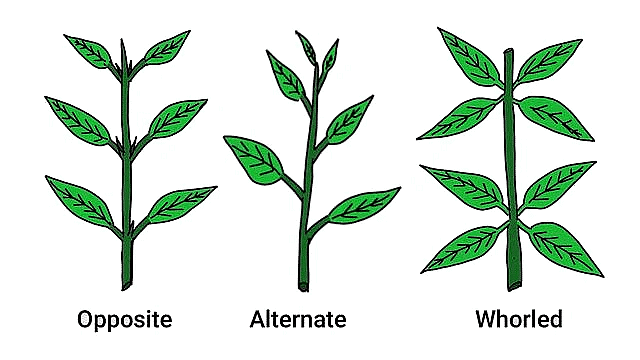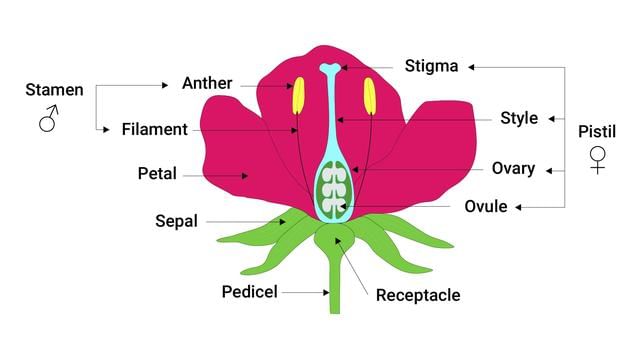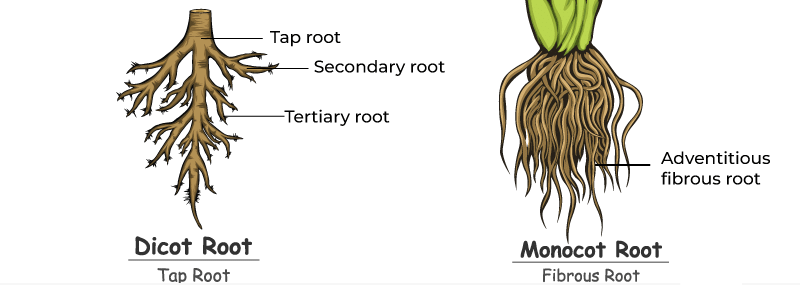Important Diagrams: Morphology of Flowering Plants | Biology Class 11 - NEET PDF Download

Diagrams in the morphology of flowering plants bring clarity to complex concepts like root and shoot modifications and floral families helping NEET aspirants to understand how floral structures and their modifications and functions are categorized into various groups based on their characteristics.
Parts of a Flowering Plant
Morphology is the branch of biological science that deals with the study of the form, size, color, structure, and relative position of various parts of plant. All the flowering plants have roots, stems, leaves, flowers, and fruits. The underground parts of the flowering plant are the root system and the portion above the ground forms the shoot system.
 Parts of Plant
Parts of Plant
1. The Root- Structure & Types
Roots are a crucial underground component of all vascular plants. They play a key role in securing the plants in the soil and extracting vital minerals, nutrients, and water from the earth. Additionally, roots serve as a storage facility for food.
(a) Regions of Root
 Regions of Root
Regions of Root
- Root Cap: Protects the delicate growing tip of the root and aids in penetration through soil particles.
- Meristematic Region: Contains actively dividing cells responsible for root growth and development.
- Elongation Zone: Area where cells elongate, contributing to root lengthening.
- Maturation Zone: Where cells differentiate into various specialized tissues such as xylem, phloem, and root hairs for absorption and support.
- Zone of Root Hairs: Region with tiny hair-like structures that greatly increase the surface area for absorption of water and minerals from the soil.(b) Types of Root
- A taproot system consists of a primary central root with lateral root hairs attached to it. Plants like mustard, carrot, beetroot, parsley, and china rose exhibit this type of root system.
- A fibrous root systems are characterized by thin, branching roots originating from the stem. Examples include rice, wheat, maize, marigold, and banana.
 Types of Root
Types of Root
(c) Modifications of Root
Some plants modify their roots for different tasks like storing food, providing support, or getting oxygen. For example, carrots and turnips store food in their swollen taproots, while banyan trees have hanging roots called prop roots for support. Maize and sugarcane have stilt roots for stability, and plants like Rhizophora grow pneumatophores in swampy areas to breathe.
2. The Stem - Structure & Types
The stem is the upward-growing section of a plant's structure that supports branches, leaves, flowers, and fruits. It originates from the plumule of a seed's embryo during germination and contains nodes and internodes.
The stem contains nodes, where leaves emerge, and internodes, the sections between nodes. It also carries buds, either at the end (terminal) or along the sides (axillary). Initially green, stems can mature into woody, dark brown structures. Their primary role is to support branches holding leaves, flowers, and fruits, as well as transport water, minerals, and photosynthates
 Structure of Stem
Structure of Stem
(a) Modifications of Stem
- Aerial Modifications: These are changes that occur above ground. Examples include thorns and spines for protection, tendrils for climbing, and storage organs like bulbs and tubers.
- Subaerial Modifications: These modifications occur partly above ground and are often related to reproduction or support. Examples include runners (horizontal stems) for vegetative propagation and stolons (above-ground stems) for rooting at nodes.
- Underground Modifications: These are changes that occur beneath the soil surface. Examples include rhizomes for storage and spreading, tubers for food storage, and bulbs for nutrient storage and propagation.
Each type of modification helps plants in different ways, such as protecting them from predators, aiding in reproduction, or storing nutrients for future growth
 Modifications of Stem
Modifications of Stem
3. The Leaf
A leaf is like a flat green part of a plant that grows from a stem. It's really important for the plant because it helps make food through a process called photosynthesis. A leaf has three main parts: the base that attaches it to the stem, the petiole that helps hold it up, and the lamina or leaf blade.
(a) Parts of Leaf
- Leaf Blade: The leaf base provides stability and support for the leaf’s attachment to the plant and can also play a role in water and nutrient transport.
- Lamina: The lamina contains chloroplasts, which are responsible for capturing sunlight and converting it into energy for the plant.
- Petioles: The petiole helps position the leaf so that it can receive sunlight effectively, enabling the process of photosynthesis to occur efficiently.
 Structure of Leaf
Structure of Leaf
(b) Venation
Venation, also known as leaf venation, pertains to the organization or configuration of veins and veinlets within the leaf blade. In essence, it describes the arrangement of vascular tissues within a leaf.
Types of Venation
The two main types of venation are parallel venation, where the veins run parallel to each other, and reticulate or netted, where veins form a branching network.
- Pinnate venation: In this type there is a central mid-rib, or main vein, from which lateral veins extend outward perpendicular to it, running parallel towards the leaf's edge.
- Palmate venation: It involves two or more principal veins originating from a single point at the leaf's base and extending outward or upward, resembling the fingers of a hand.
 Types of Venation
Types of Venation
(c) Types of Leaves
The leaves are mainly of two different types: Simple Leaves and Compound Leaves depending upon the incision of the lamina.
- Simple Leaves: Simple leaves are those leaves that are not divided into smaller leaflets. Some common examples of plants with simple leaves include Oak trees, Maple trees, and Roses.
- Compound Leaves: Compound leaves are divided into smaller leaflets, each with its own petiole. It reduces water loss and makes the leaves well-suited to environments with strong winds or arid conditions.
 Types of Leaf
Types of Leaf
(c) Phyllotaxy
Phyllotaxy refers to the pattern or arrangement of leaves on the stem or branches of a plant. This arrangement is not random but follows specific patterns that are characteristic of each plant species. Phyllotaxy is determined by the genetic makeup of the plant and various environmental factors.Types of Phyllotaxy
- Alternate Phyllotaxy: In this arrangement, a single leaf develops at each node of the stem alternately. A classic example is the rose plant.
- Opposite Phyllotaxy: This type of arrangement features a pair of leaves emerging opposite each other at each node of the stem. An illustration is seen in the guava plant.
- Whorled Phyllotaxy: Here, more than two leaves sprout at each node of the stem, forming a whorl-like pattern. The sunflower is a notable example exhibiting this type of arrangement.
 Types of Phyllotaxy
Types of Phyllotaxy
4. Inflorescence
A flower is a changed part of a plant where the top part becomes a flower instead of growing more stems. The stem becomes shorter and thicker. Instead of leaves, the top part makes different parts of the flower at each level. Flowers always grow alone when the top of the plant turns into one. How the flowers are arranged on the stem is called inflorescence.

5. Parts of a Flower
The majority of flowers consist of four primary components: sepals, petals, stamens, and carpels. Stamens function as the male reproductive organs, while carpels serve as the female reproductive organs. Typically, flowers are hermaphroditic, possessing both male and female parts. However, some flowers may contain only one of these parts, rendering them either male or female.
 Structure of Flower
Structure of Flower
- Receptacles: It is the base of the flower where all the floral organs (such as petals, sepals, and stamen) are attached.
- Sepals: The leaf-like structures found at the base of a flower protect the flower during its budding stage and can be green or colored.

- Petals: They are the most beautiful, colorful, and delicate parts of a flower. The petals surround the reproductive organs, they also help in attracting pollinators, which leads to the process of pollination.

- Stamen: The stamen is the male reproductive part of a flower, consisting of filament and anther. The anther produces pollen, while the filament holds the anther in place.

- Carpel: The carpel is a female reproductive structure of a flower, consisting of a stigma, style, and ovary.

6. Position of Floral Parts on Thalamus
Flowers are classified into three types on the basis of the position of the ovary which is Hypognous, perigynous, epigynous are the three types of the floral arrangement based on the position of the ovary.
- In hypogynous the ovary occupies the highest position over the thalamus.
- In perigynous, the ovary is situated at the centre.
- In epigynous the thalamus grow around the ovary fusing with its wall.
 7. Aestivation
7. Aestivation
An arrangement of sepals and petals within floral buds in relation to other parts of the whorl, serving as a crucial factor in flower identification.
- Valvate aestivation: Sepals and petals in the whorl touch at the edges but do not overlap. Examples: Calotropis, Lilac, certain Annonaceae family members.
- Imbricate aestivation: Sepals and petals overlap each other without a specific pattern. Examples: Gulmohar, Cassia.
- Twisted aestivation: Petals and sepals overlap in a single direction, giving a twisted appearance. Examples: Ladyfinger, Cotton, Chinarose.
- Vexillary aestivation: Also called papilionaceous, involves five petals where the largest overlaps two front petals, which overlap two smaller ones. Examples: Pea, Bean flowers.
- Quincuncial aestivation: Whorls arranged spirally, with three outer petals overshadowing two inner ones. Examples: Guava.

8. Structure of Monocot & Dicot Seed
A seed is a basic part of any plant. The ovules after fertilization, develop into seeds. A seed is made up of a seed coat and an embryo. The embryo is made up of a radicle, an embryonal axis and one (wheat, maize) or two cotyledons (gram and pea). A seed is found inside a fruit which converts into a new plant when we plant it.(a) Structure of a Dicot Seed
A dicot seed primarily consists of two basic parts- seed coat and embryo. The surface of the seed may be smooth or wrinkled. An outer seed coat ' tegmen' and an inner seed coat 'testa' covers the seed coat.

- Dicotyledon seeds contain an embryonal axis and two fleshy cotyledons serving as food reserves.
- Cotyledons are photosynthetic, providing sustenance for the growing embryo.
- The seed coat comprises the outer testa and inner tegmen layers, with the hilum as the connection point to the fruit.
- A small pore above the hilum is called the micropyle.
- The embryo consists of two cotyledons attached to the primary axis, with rudimentary leaves known as plumule and radicle.
- The radicle forms the root, and the plumule develops into the shoot.
- The area between plumule and micropyle is termed epicotyl, while the region between radicle and micropyle is called hypocotyl.
(b) Structure of a Monocot Seed
A monocotyledonous seed has embryos that possess only one large cotyledon called scutellum. Generally, the scutellum is shaped like a shield. It is located laterally towards the side of the embryo axis. Like dicotyledons, the embryo axis of monocotyledons possesses a shoot tip called the plumule.

- Seed coat: A thin, protective covering around the maize seed made up of a combination of seed cover and fruit wall.
- Endosperm: The inside of the seed, divided into two parts by a clear layer. The upper part is larger and called endosperm, while the lower part is smaller and called the embryo.
- Embryo: Found at the bottom of the endosperm, it consists of a single cotyledon, a radicle (which grows into the root), and a plumule (which grows into the shoot). The radicle end is protected by a sheath called coleorhiza, and the plumule end is protected by a sheath called coleoptile.
- Cotyledon: In maize seeds, the cotyledon is a hard, triangular structure called Scutellum. It connects to the endosperm and its role is to absorb nutrients from the endosperm and provide them to the growing embryo.
Diagram Based Previous Year Question- NEET
Q1: Given below are two statements: One is labelled as Assertion A and the other is labelled as Reason R :
Assertion A: A flower is defined as a modified shoot wherein the shoot apical meristem changes to floral meristem.
Reason R: Internode of the shoot gets condensed to produce different floral appendages laterally at successive nodes instead of leaves.
In the light of the above statements, choose the correct answer from the options given below : (2023)
(a) Both A and R are true and R is the correct explanation of A
(b) Both A and R are true but R is NOT the correct explanation of A
(c) A is true but R is false
(d) A is false but R is true
Ans: (a)
Sol:
Parts of Plant
A flower is a modified shoot wherein the shoot apical meristem changes to floral meristem. Internodes do not elongate and the axis gets condensed. The apex produces different kinds of floral appendages laterally at the successive nodes instead of leaves.
Therefore, both A and R are true and R is correct explanation of A.
Q2: The roots that originate from the base of the stem are:
(a) Prop roots
(b) Lateral roots
(c) Fibrous roots
(d) Primary roots
Ans: (c) Sol: Roots that originate from the base of stem constitute the fibrous root system as seen in the monocots example wheat plant.
Types of Root
|
180 videos|362 docs|148 tests
|
FAQs on Important Diagrams: Morphology of Flowering Plants - Biology Class 11 - NEET
| 1. What are the main functions of the root in a flowering plant? |  |
| 2. How do monocot and dicot seeds differ in structure? |  |
| 3. What are the different types of stems and their functions? |  |
| 4. What are the parts of a flower and their roles? |  |
| 5. How are floral parts positioned on the thalamus of a flower? |  |




















